Theodore Dreiser (1871-1945) American author, outstanding representative of

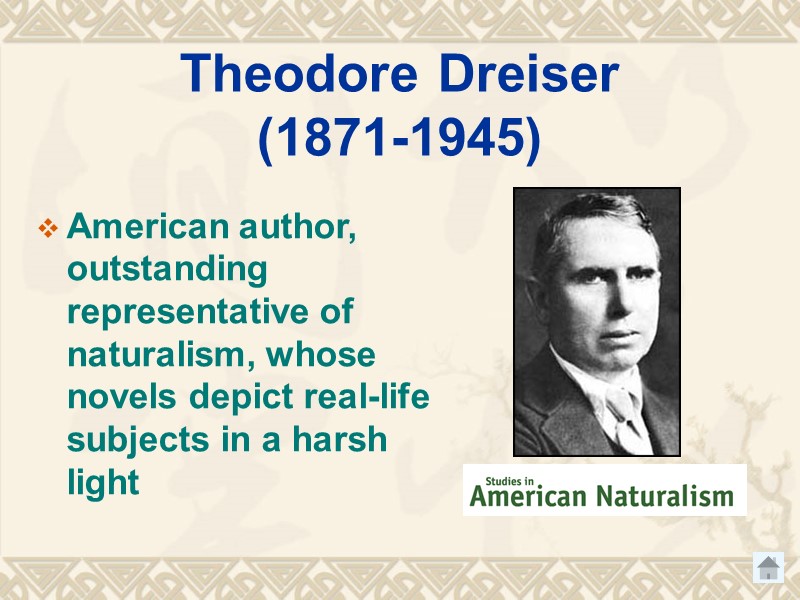
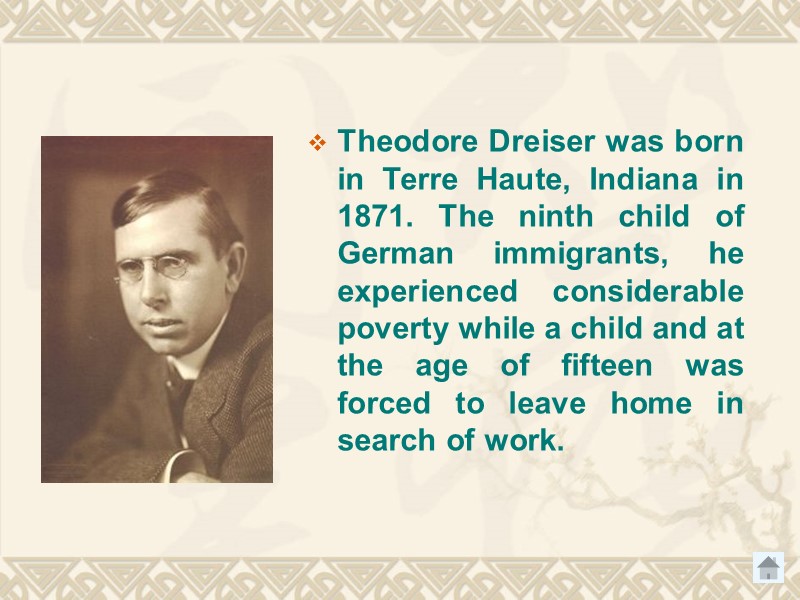
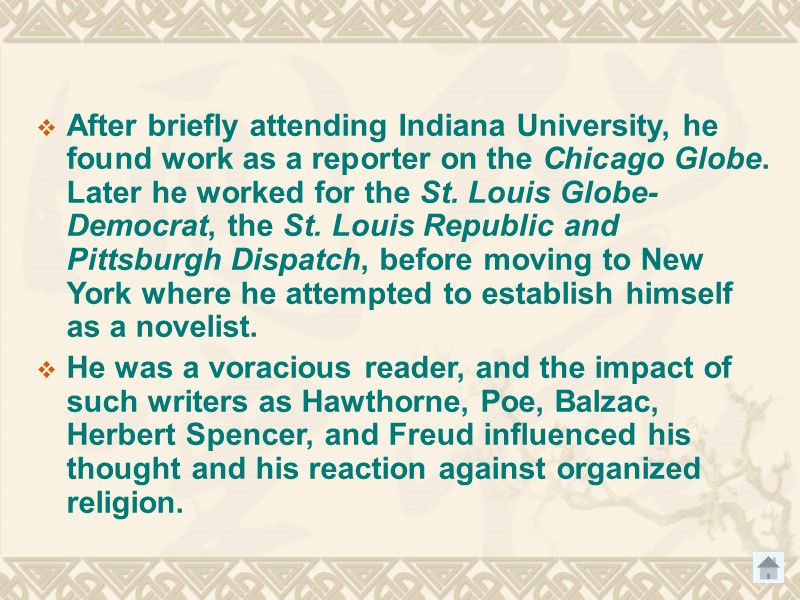
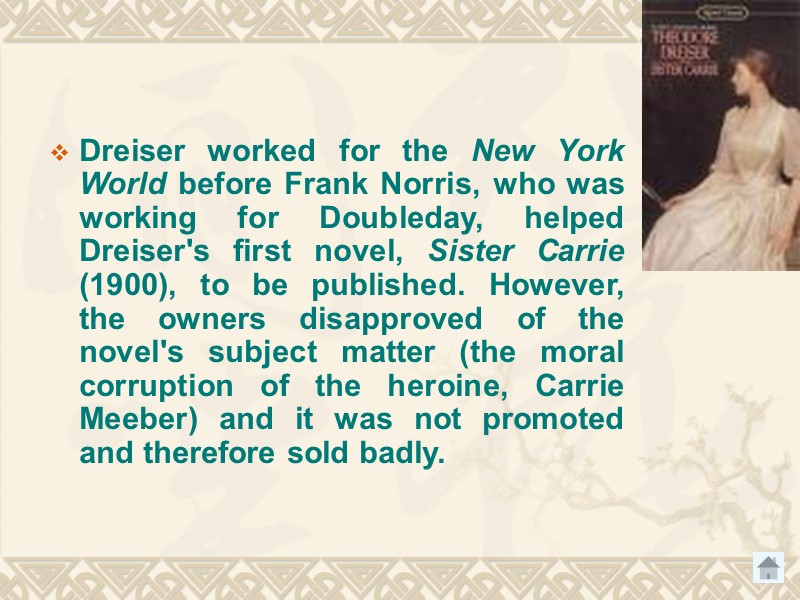
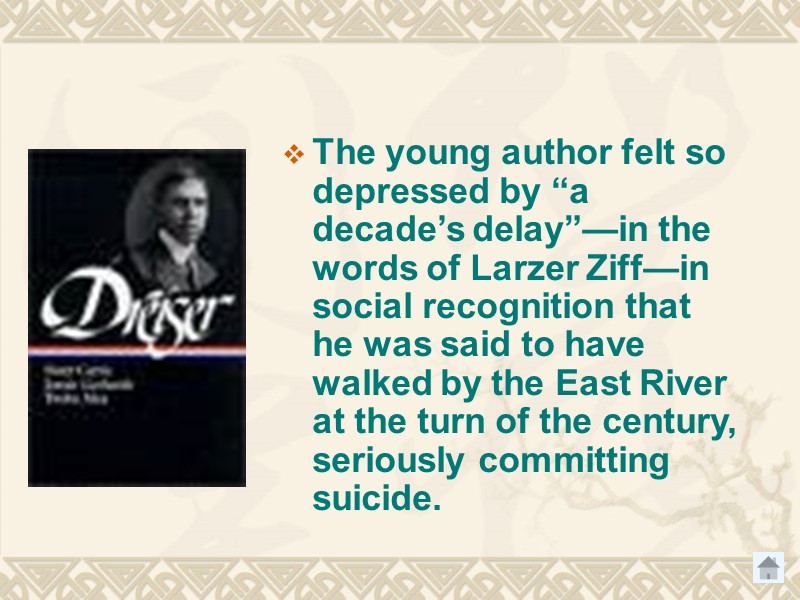
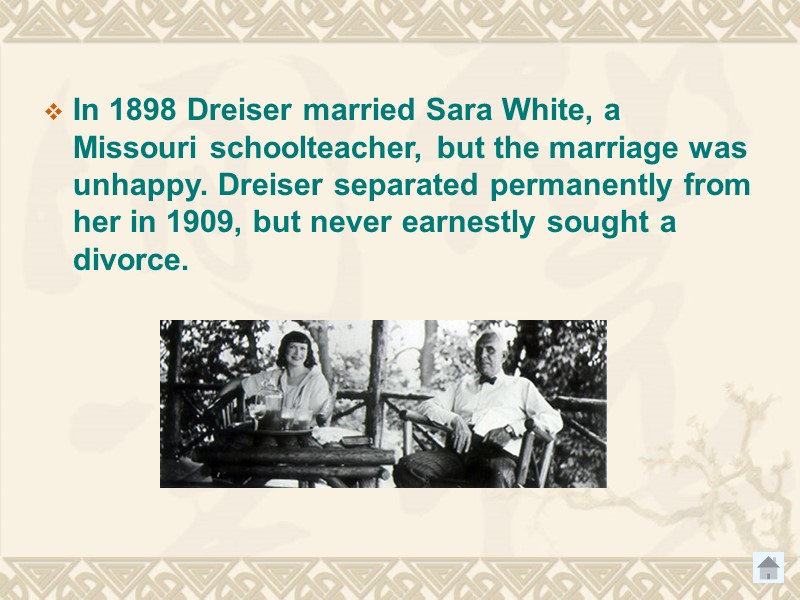
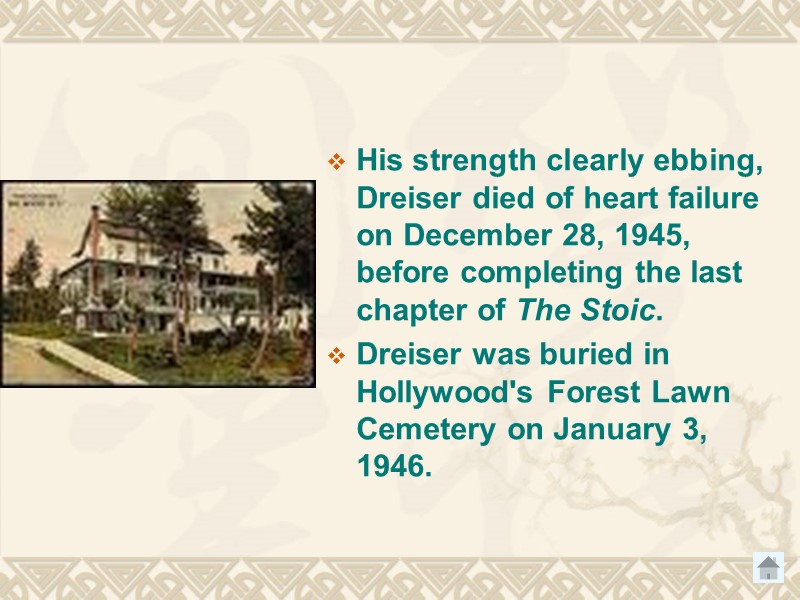
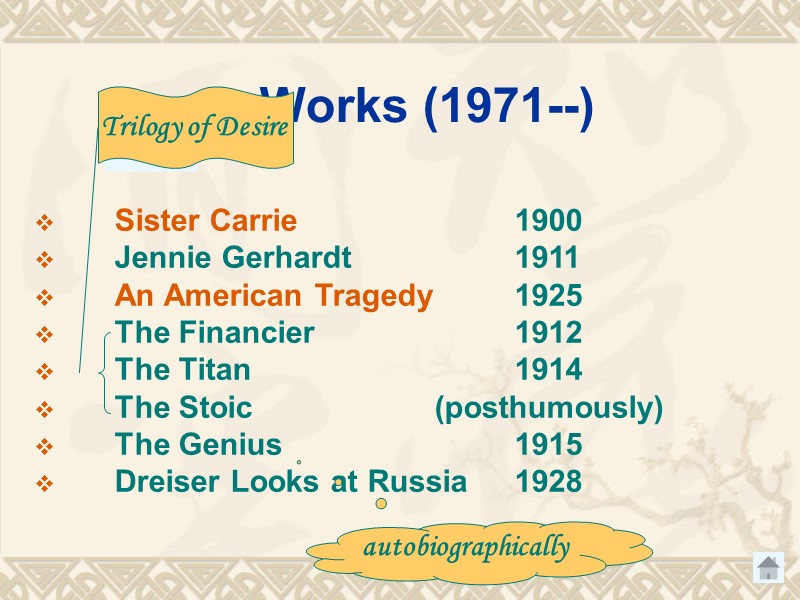

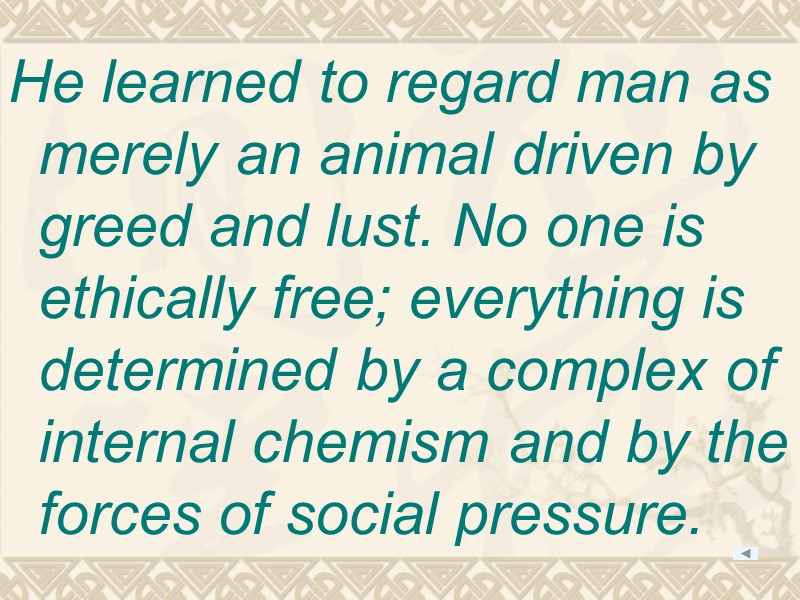
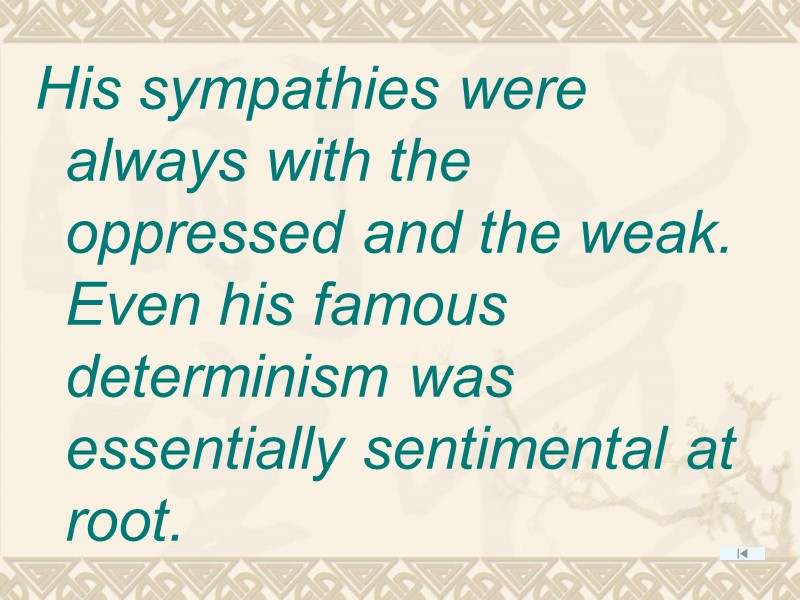
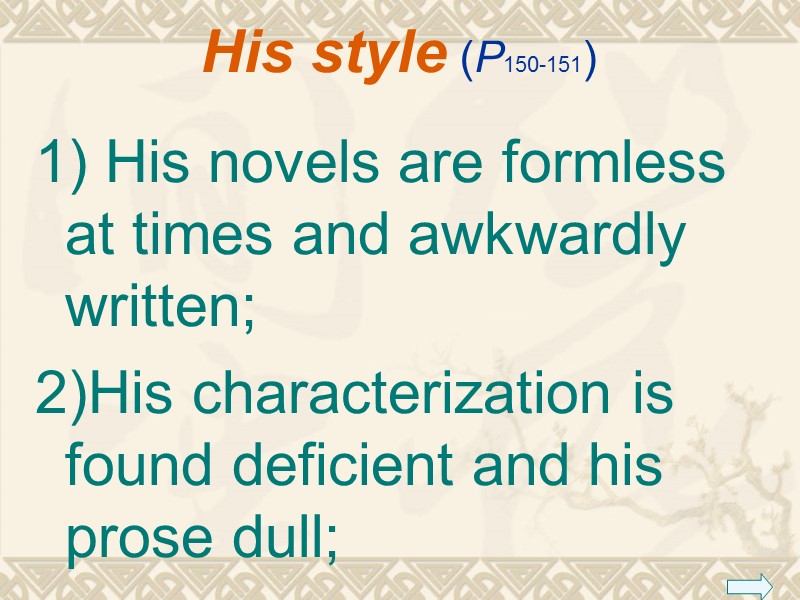


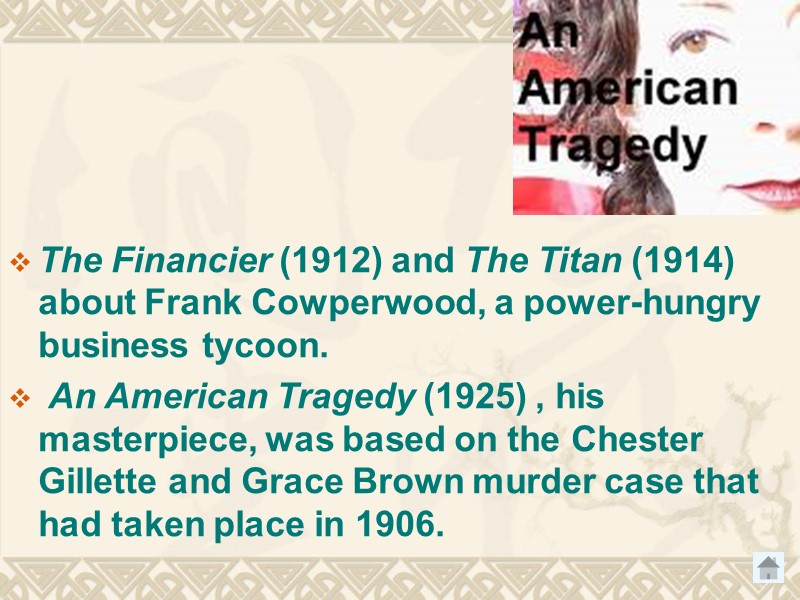
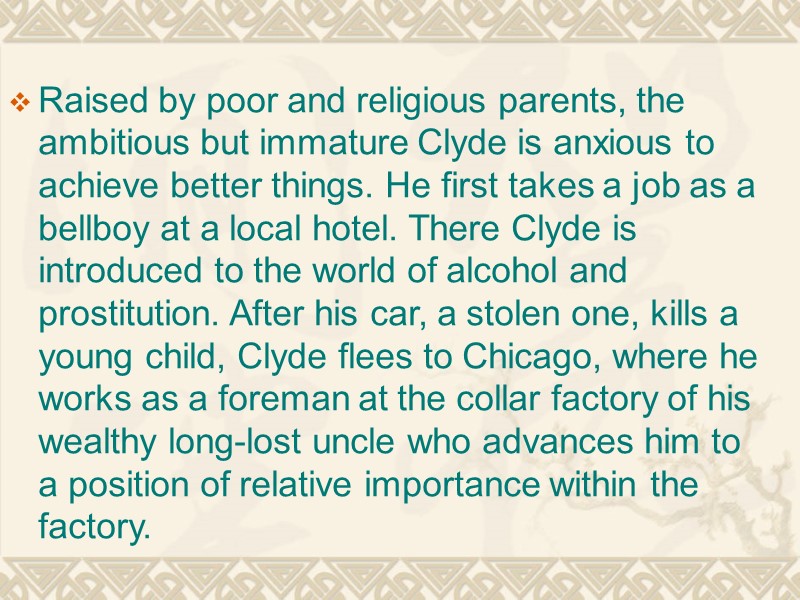

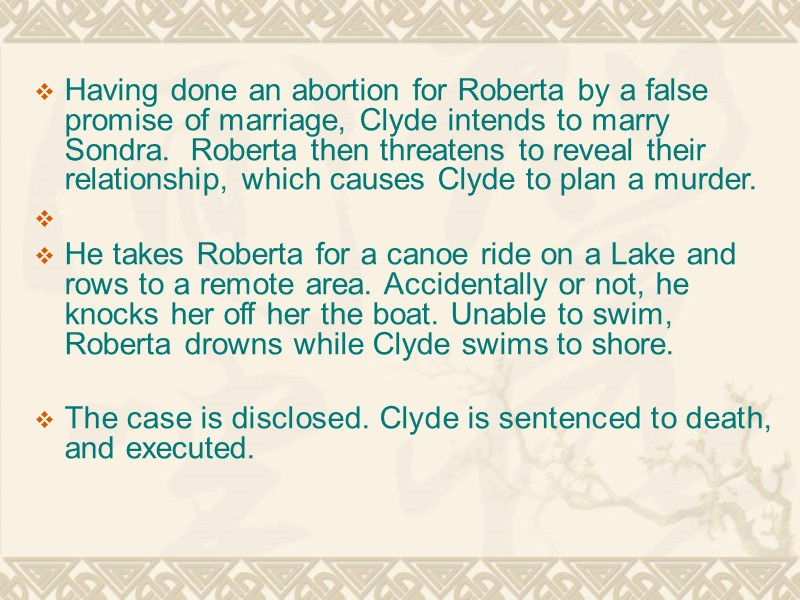
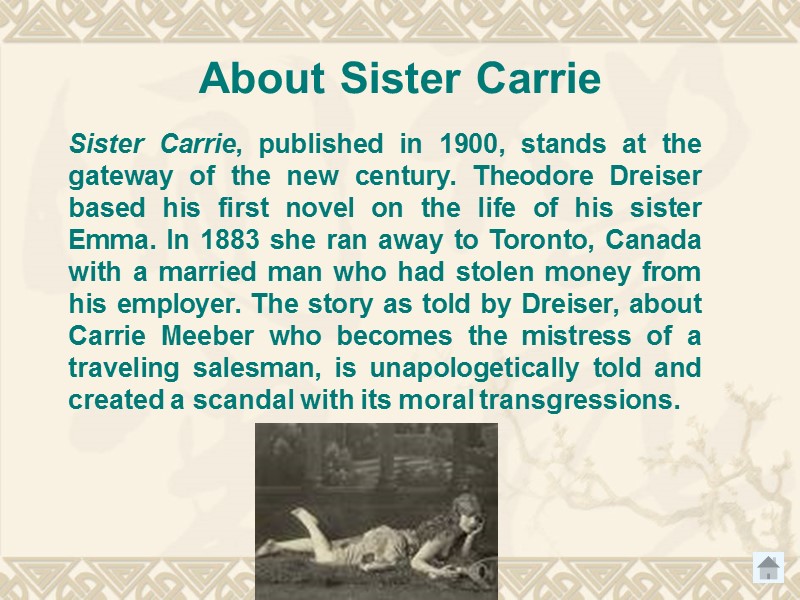
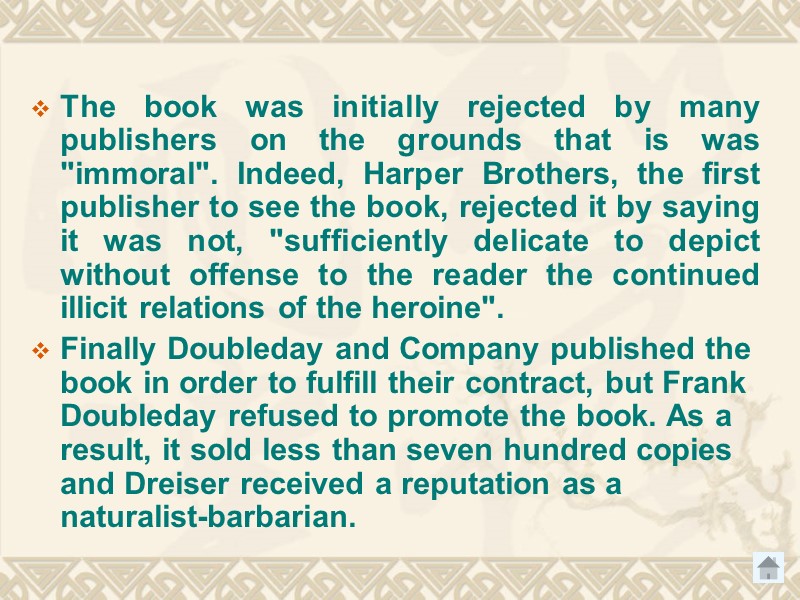
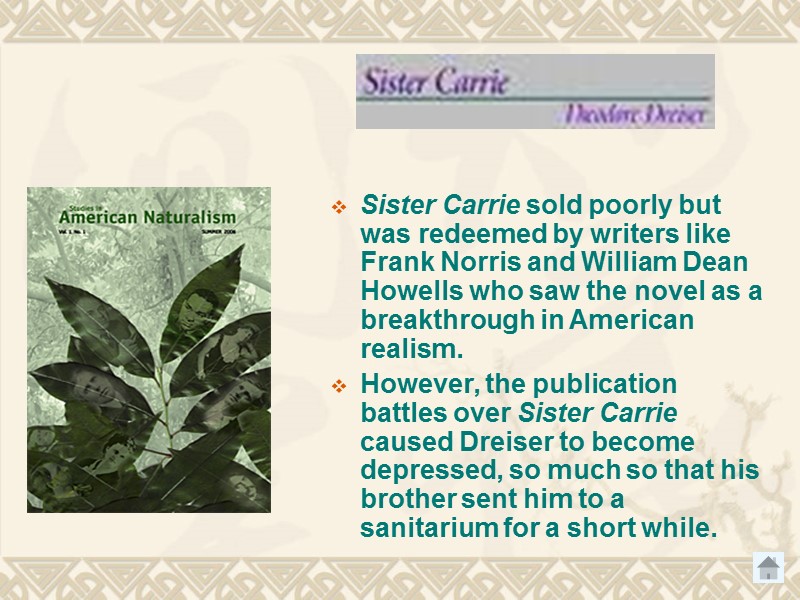
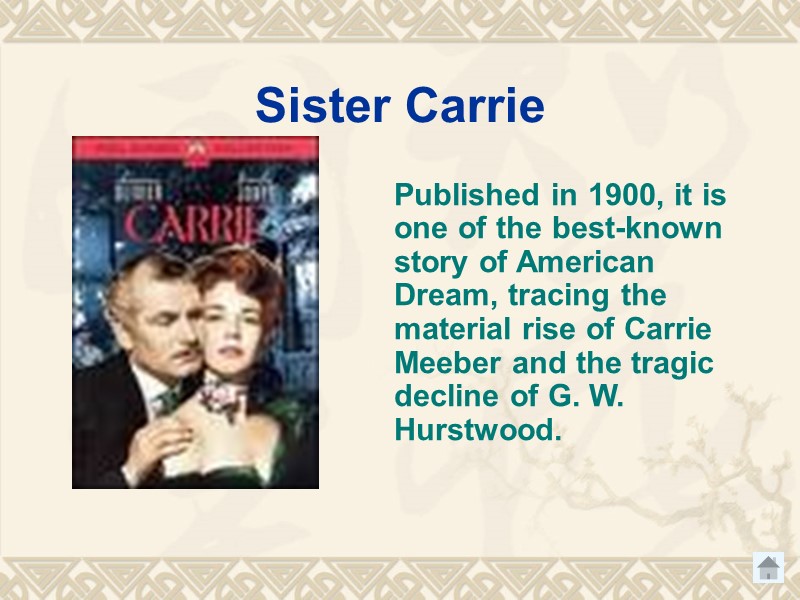
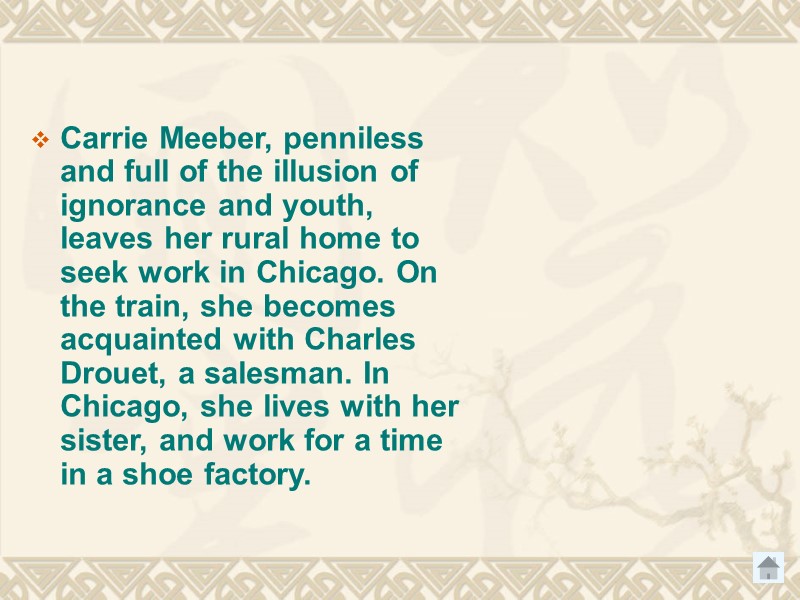
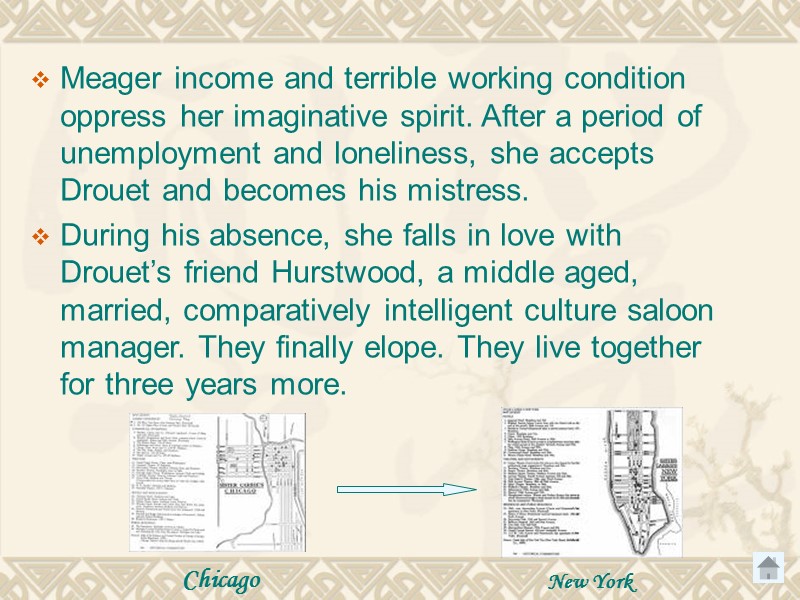

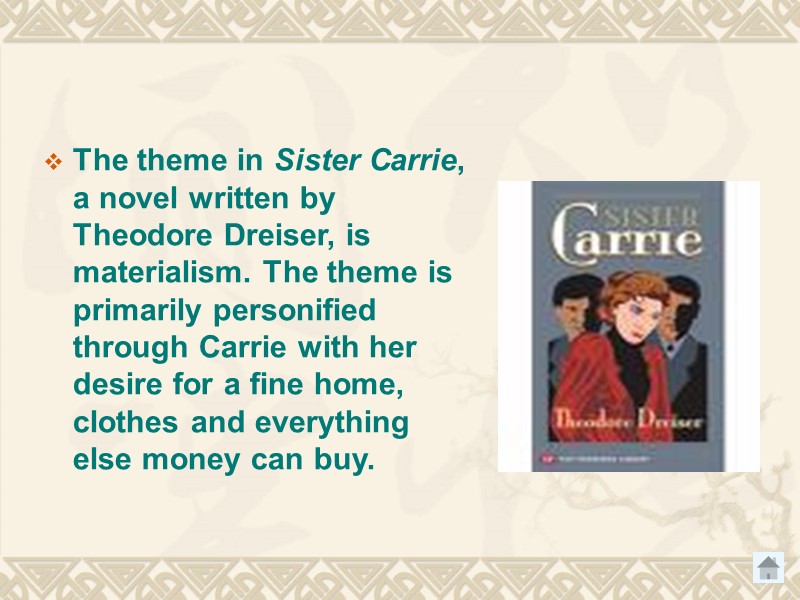
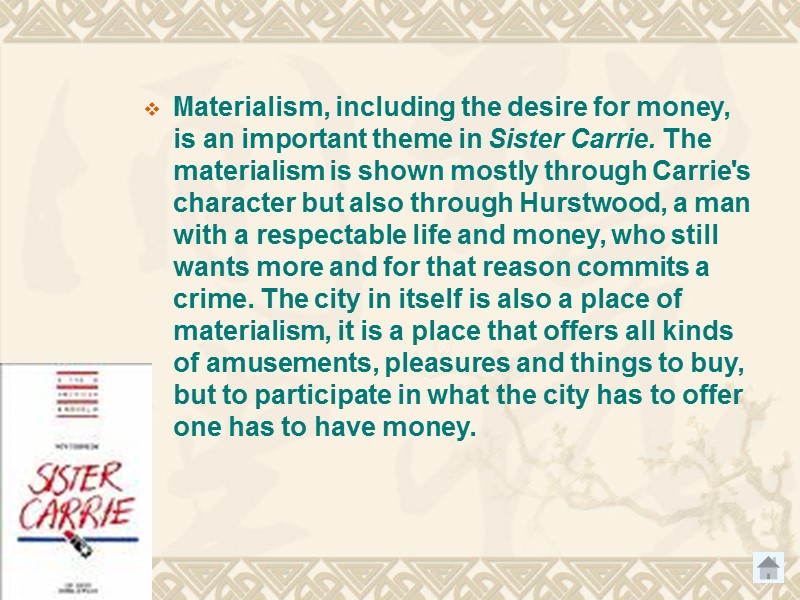
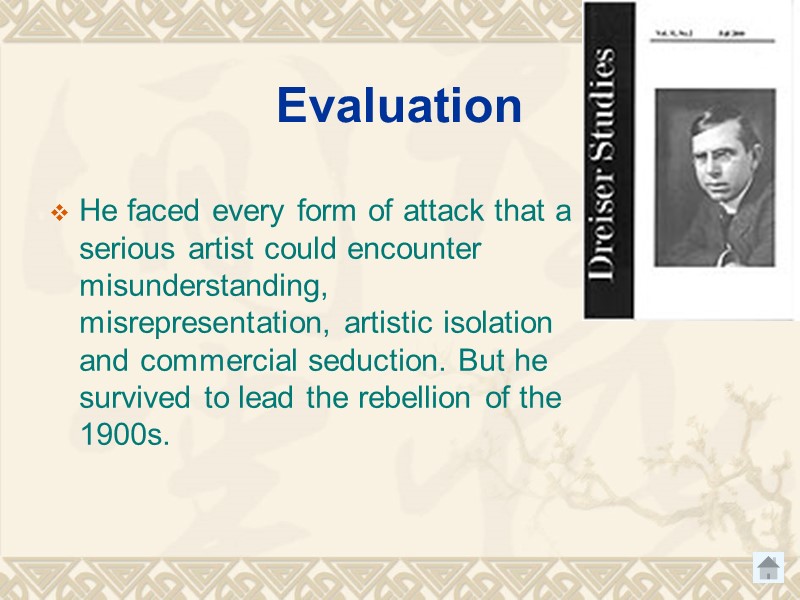
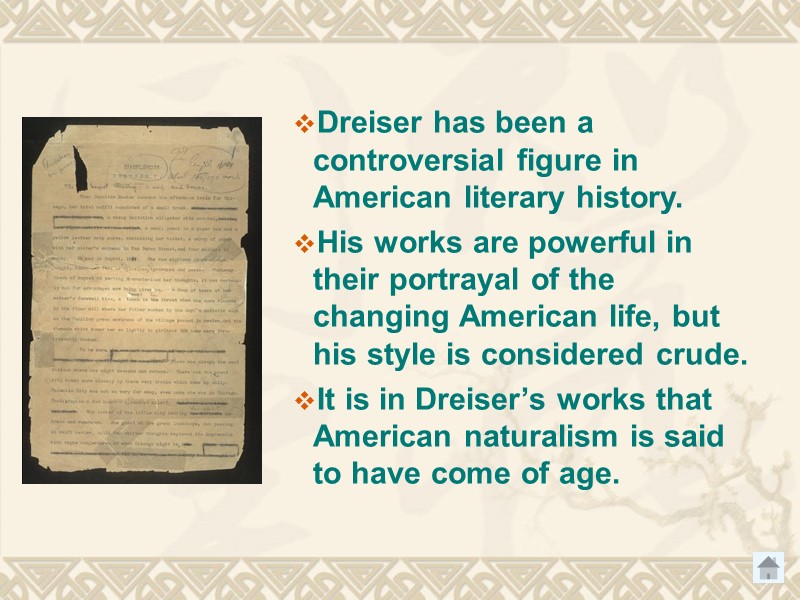
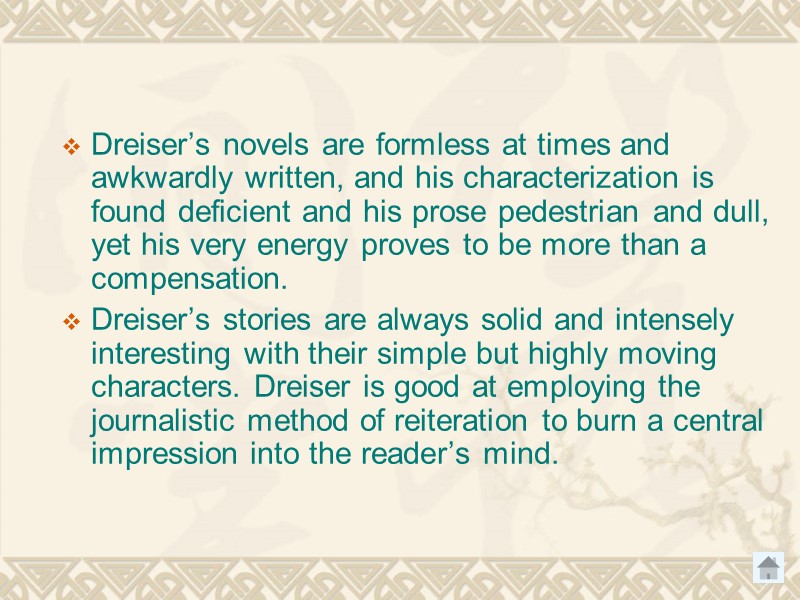
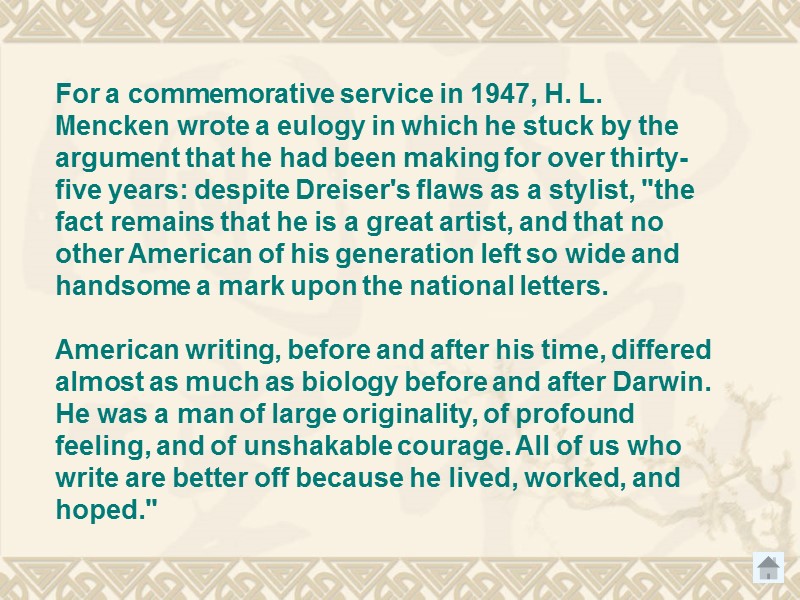
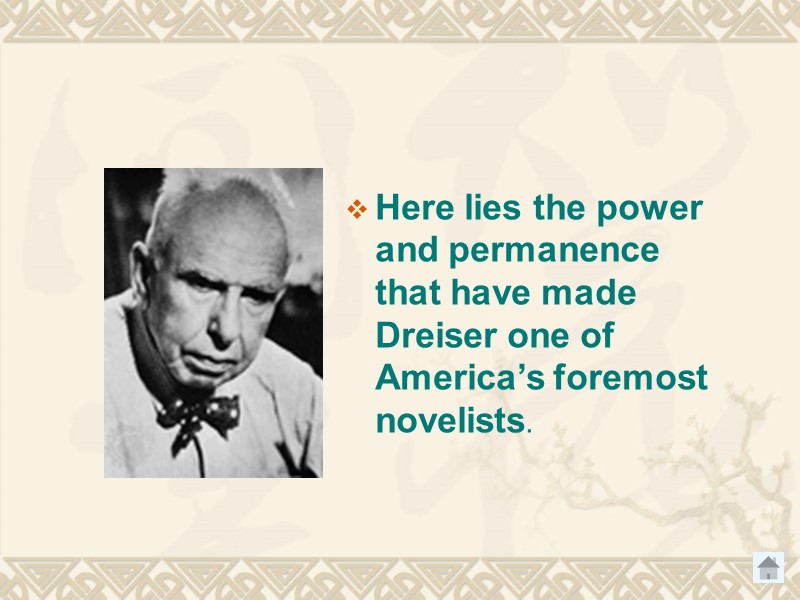
25194-theodore_dreiser.ppt
- Количество слайдов: 32
 Theodore Dreiser (1871-1945) American author, outstanding representative of naturalism, whose novels depict real-life subjects in a harsh light
Theodore Dreiser (1871-1945) American author, outstanding representative of naturalism, whose novels depict real-life subjects in a harsh light
 Theodore Dreiser was born in Terre Haute, Indiana in 1871. The ninth child of German immigrants, he experienced considerable poverty while a child and at the age of fifteen was forced to leave home in search of work.
Theodore Dreiser was born in Terre Haute, Indiana in 1871. The ninth child of German immigrants, he experienced considerable poverty while a child and at the age of fifteen was forced to leave home in search of work.
 After briefly attending Indiana University, he found work as a reporter on the Chicago Globe. Later he worked for the St. Louis Globe-Democrat, the St. Louis Republic and Pittsburgh Dispatch, before moving to New York where he attempted to establish himself as a novelist. He was a voracious reader, and the impact of such writers as Hawthorne, Poe, Balzac, Herbert Spencer, and Freud influenced his thought and his reaction against organized religion.
After briefly attending Indiana University, he found work as a reporter on the Chicago Globe. Later he worked for the St. Louis Globe-Democrat, the St. Louis Republic and Pittsburgh Dispatch, before moving to New York where he attempted to establish himself as a novelist. He was a voracious reader, and the impact of such writers as Hawthorne, Poe, Balzac, Herbert Spencer, and Freud influenced his thought and his reaction against organized religion.
 Dreiser worked for the New York World before Frank Norris, who was working for Doubleday, helped Dreiser's first novel, Sister Carrie (1900), to be published. However, the owners disapproved of the novel's subject matter (the moral corruption of the heroine, Carrie Meeber) and it was not promoted and therefore sold badly.
Dreiser worked for the New York World before Frank Norris, who was working for Doubleday, helped Dreiser's first novel, Sister Carrie (1900), to be published. However, the owners disapproved of the novel's subject matter (the moral corruption of the heroine, Carrie Meeber) and it was not promoted and therefore sold badly.
 The young author felt so depressed by “a decade’s delay”—in the words of Larzer Ziff—in social recognition that he was said to have walked by the East River at the turn of the century, seriously committing suicide.
The young author felt so depressed by “a decade’s delay”—in the words of Larzer Ziff—in social recognition that he was said to have walked by the East River at the turn of the century, seriously committing suicide.
 In 1898 Dreiser married Sara White, a Missouri schoolteacher, but the marriage was unhappy. Dreiser separated permanently from her in 1909, but never earnestly sought a divorce.
In 1898 Dreiser married Sara White, a Missouri schoolteacher, but the marriage was unhappy. Dreiser separated permanently from her in 1909, but never earnestly sought a divorce.
 His strength clearly ebbing, Dreiser died of heart failure on December 28, 1945, before completing the last chapter of The Stoic. Dreiser was buried in Hollywood's Forest Lawn Cemetery on January 3, 1946.
His strength clearly ebbing, Dreiser died of heart failure on December 28, 1945, before completing the last chapter of The Stoic. Dreiser was buried in Hollywood's Forest Lawn Cemetery on January 3, 1946.
 1. Works (1971--) Sister Carrie 1900 Jennie Gerhardt 1911 An American Tragedy 1925 The Financier 1912 The Titan 1914 The Stoic (posthumously) The Genius 1915 Dreiser Looks at Russia 1928 autobiographically Trilogy of Desire
1. Works (1971--) Sister Carrie 1900 Jennie Gerhardt 1911 An American Tragedy 1925 The Financier 1912 The Titan 1914 The Stoic (posthumously) The Genius 1915 Dreiser Looks at Russia 1928 autobiographically Trilogy of Desire
 His view 1) He was left-oriented. (communism) 2) He embraced social Darwinism. 3) He had a warm heart.
His view 1) He was left-oriented. (communism) 2) He embraced social Darwinism. 3) He had a warm heart.
 He learned to regard man as merely an animal driven by greed and lust. No one is ethically free; everything is determined by a complex of internal chemism and by the forces of social pressure.
He learned to regard man as merely an animal driven by greed and lust. No one is ethically free; everything is determined by a complex of internal chemism and by the forces of social pressure.
 His sympathies were always with the oppressed and the weak. Even his famous determinism was essentially sentimental at root.
His sympathies were always with the oppressed and the weak. Even his famous determinism was essentially sentimental at root.
 His style (P150-151) 1) His novels are formless at times and awkwardly written; 2)His characterization is found deficient and his prose dull;
His style (P150-151) 1) His novels are formless at times and awkwardly written; 2)His characterization is found deficient and his prose dull;
 3) His stories are always solid and intensely interesting with their simple but highly moving characters.
3) His stories are always solid and intensely interesting with their simple but highly moving characters.
 4) He is good at employing the journalistic method of reiteration to burn a central impression into the reader’s mind.
4) He is good at employing the journalistic method of reiteration to burn a central impression into the reader’s mind.
 The Financier (1912) and The Titan (1914) about Frank Cowperwood, a power-hungry business tycoon. An American Tragedy (1925) , his masterpiece, was based on the Chester Gillette and Grace Brown murder case that had taken place in 1906.
The Financier (1912) and The Titan (1914) about Frank Cowperwood, a power-hungry business tycoon. An American Tragedy (1925) , his masterpiece, was based on the Chester Gillette and Grace Brown murder case that had taken place in 1906.
 Raised by poor and religious parents, the ambitious but immature Clyde is anxious to achieve better things. He first takes a job as a bellboy at a local hotel. There Clyde is introduced to the world of alcohol and prostitution. After his car, a stolen one, kills a young child, Clyde flees to Chicago, where he works as a foreman at the collar factory of his wealthy long-lost uncle who advances him to a position of relative importance within the factory.
Raised by poor and religious parents, the ambitious but immature Clyde is anxious to achieve better things. He first takes a job as a bellboy at a local hotel. There Clyde is introduced to the world of alcohol and prostitution. After his car, a stolen one, kills a young child, Clyde flees to Chicago, where he works as a foreman at the collar factory of his wealthy long-lost uncle who advances him to a position of relative importance within the factory.
 Though forbidden by factory rules, Clyde starts an affair with Roberta Alden, a poor and very innocent farm girl working under him. The girl discovers her pregnancy when Clyde develops a relationship with Sondra Finchley, the daughter of a wealthy friend of his uncle's, whom his ambition says he should marry instead of the poor Roberta.
Though forbidden by factory rules, Clyde starts an affair with Roberta Alden, a poor and very innocent farm girl working under him. The girl discovers her pregnancy when Clyde develops a relationship with Sondra Finchley, the daughter of a wealthy friend of his uncle's, whom his ambition says he should marry instead of the poor Roberta.
 Having done an abortion for Roberta by a false promise of marriage, Clyde intends to marry Sondra. Roberta then threatens to reveal their relationship, which causes Clyde to plan a murder. He takes Roberta for a canoe ride on a Lake and rows to a remote area. Accidentally or not, he knocks her off her the boat. Unable to swim, Roberta drowns while Clyde swims to shore. The case is disclosed. Clyde is sentenced to death, and executed.
Having done an abortion for Roberta by a false promise of marriage, Clyde intends to marry Sondra. Roberta then threatens to reveal their relationship, which causes Clyde to plan a murder. He takes Roberta for a canoe ride on a Lake and rows to a remote area. Accidentally or not, he knocks her off her the boat. Unable to swim, Roberta drowns while Clyde swims to shore. The case is disclosed. Clyde is sentenced to death, and executed.
 About Sister Carrie Sister Carrie, published in 1900, stands at the gateway of the new century. Theodore Dreiser based his first novel on the life of his sister Emma. In 1883 she ran away to Toronto, Canada with a married man who had stolen money from his employer. The story as told by Dreiser, about Carrie Meeber who becomes the mistress of a traveling salesman, is unapologetically told and created a scandal with its moral transgressions.
About Sister Carrie Sister Carrie, published in 1900, stands at the gateway of the new century. Theodore Dreiser based his first novel on the life of his sister Emma. In 1883 she ran away to Toronto, Canada with a married man who had stolen money from his employer. The story as told by Dreiser, about Carrie Meeber who becomes the mistress of a traveling salesman, is unapologetically told and created a scandal with its moral transgressions.
 The book was initially rejected by many publishers on the grounds that is was "immoral". Indeed, Harper Brothers, the first publisher to see the book, rejected it by saying it was not, "sufficiently delicate to depict without offense to the reader the continued illicit relations of the heroine". Finally Doubleday and Company published the book in order to fulfill their contract, but Frank Doubleday refused to promote the book. As a result, it sold less than seven hundred copies and Dreiser received a reputation as a naturalist-barbarian.
The book was initially rejected by many publishers on the grounds that is was "immoral". Indeed, Harper Brothers, the first publisher to see the book, rejected it by saying it was not, "sufficiently delicate to depict without offense to the reader the continued illicit relations of the heroine". Finally Doubleday and Company published the book in order to fulfill their contract, but Frank Doubleday refused to promote the book. As a result, it sold less than seven hundred copies and Dreiser received a reputation as a naturalist-barbarian.
 Sister Carrie sold poorly but was redeemed by writers like Frank Norris and William Dean Howells who saw the novel as a breakthrough in American realism. However, the publication battles over Sister Carrie caused Dreiser to become depressed, so much so that his brother sent him to a sanitarium for a short while.
Sister Carrie sold poorly but was redeemed by writers like Frank Norris and William Dean Howells who saw the novel as a breakthrough in American realism. However, the publication battles over Sister Carrie caused Dreiser to become depressed, so much so that his brother sent him to a sanitarium for a short while.
 Sister Carrie Published in 1900, it is one of the best-known story of American Dream, tracing the material rise of Carrie Meeber and the tragic decline of G. W. Hurstwood.
Sister Carrie Published in 1900, it is one of the best-known story of American Dream, tracing the material rise of Carrie Meeber and the tragic decline of G. W. Hurstwood.
 Carrie Meeber, penniless and full of the illusion of ignorance and youth, leaves her rural home to seek work in Chicago. On the train, she becomes acquainted with Charles Drouet, a salesman. In Chicago, she lives with her sister, and work for a time in a shoe factory.
Carrie Meeber, penniless and full of the illusion of ignorance and youth, leaves her rural home to seek work in Chicago. On the train, she becomes acquainted with Charles Drouet, a salesman. In Chicago, she lives with her sister, and work for a time in a shoe factory.
 Meager income and terrible working condition oppress her imaginative spirit. After a period of unemployment and loneliness, she accepts Drouet and becomes his mistress. During his absence, she falls in love with Drouet’s friend Hurstwood, a middle aged, married, comparatively intelligent culture saloon manager. They finally elope. They live together for three years more. Chicago New York
Meager income and terrible working condition oppress her imaginative spirit. After a period of unemployment and loneliness, she accepts Drouet and becomes his mistress. During his absence, she falls in love with Drouet’s friend Hurstwood, a middle aged, married, comparatively intelligent culture saloon manager. They finally elope. They live together for three years more. Chicago New York
 Carrie becomes mature in intellect and emotion, while Hurstwood steadily declines. At last, she thinks him too great a burden and leaves him. Hurstwood sinks lower and lower. After becoming a beggar, he commits suicide, while Carrie becomes a star of musical comedy. In spite of her success, she is lonely and dissatisfied.
Carrie becomes mature in intellect and emotion, while Hurstwood steadily declines. At last, she thinks him too great a burden and leaves him. Hurstwood sinks lower and lower. After becoming a beggar, he commits suicide, while Carrie becomes a star of musical comedy. In spite of her success, she is lonely and dissatisfied.
 The theme in Sister Carrie, a novel written by Theodore Dreiser, is materialism. The theme is primarily personified through Carrie with her desire for a fine home, clothes and everything else money can buy.
The theme in Sister Carrie, a novel written by Theodore Dreiser, is materialism. The theme is primarily personified through Carrie with her desire for a fine home, clothes and everything else money can buy.
 Materialism, including the desire for money, is an important theme in Sister Carrie. The materialism is shown mostly through Carrie's character but also through Hurstwood, a man with a respectable life and money, who still wants more and for that reason commits a crime. The city in itself is also a place of materialism, it is a place that offers all kinds of amusements, pleasures and things to buy, but to participate in what the city has to offer one has to have money.
Materialism, including the desire for money, is an important theme in Sister Carrie. The materialism is shown mostly through Carrie's character but also through Hurstwood, a man with a respectable life and money, who still wants more and for that reason commits a crime. The city in itself is also a place of materialism, it is a place that offers all kinds of amusements, pleasures and things to buy, but to participate in what the city has to offer one has to have money.
 Evaluation He faced every form of attack that a serious artist could encounter misunderstanding, misrepresentation, artistic isolation and commercial seduction. But he survived to lead the rebellion of the 1900s.
Evaluation He faced every form of attack that a serious artist could encounter misunderstanding, misrepresentation, artistic isolation and commercial seduction. But he survived to lead the rebellion of the 1900s.
 Dreiser has been a controversial figure in American literary history. His works are powerful in their portrayal of the changing American life, but his style is considered crude. It is in Dreiser’s works that American naturalism is said to have come of age.
Dreiser has been a controversial figure in American literary history. His works are powerful in their portrayal of the changing American life, but his style is considered crude. It is in Dreiser’s works that American naturalism is said to have come of age.
 Dreiser’s novels are formless at times and awkwardly written, and his characterization is found deficient and his prose pedestrian and dull, yet his very energy proves to be more than a compensation. Dreiser’s stories are always solid and intensely interesting with their simple but highly moving characters. Dreiser is good at employing the journalistic method of reiteration to burn a central impression into the reader’s mind.
Dreiser’s novels are formless at times and awkwardly written, and his characterization is found deficient and his prose pedestrian and dull, yet his very energy proves to be more than a compensation. Dreiser’s stories are always solid and intensely interesting with their simple but highly moving characters. Dreiser is good at employing the journalistic method of reiteration to burn a central impression into the reader’s mind.
 For a commemorative service in 1947, H. L. Mencken wrote a eulogy in which he stuck by the argument that he had been making for over thirty-five years: despite Dreiser's flaws as a stylist, "the fact remains that he is a great artist, and that no other American of his generation left so wide and handsome a mark upon the national letters. American writing, before and after his time, differed almost as much as biology before and after Darwin. He was a man of large originality, of profound feeling, and of unshakable courage. All of us who write are better off because he lived, worked, and hoped."
For a commemorative service in 1947, H. L. Mencken wrote a eulogy in which he stuck by the argument that he had been making for over thirty-five years: despite Dreiser's flaws as a stylist, "the fact remains that he is a great artist, and that no other American of his generation left so wide and handsome a mark upon the national letters. American writing, before and after his time, differed almost as much as biology before and after Darwin. He was a man of large originality, of profound feeling, and of unshakable courage. All of us who write are better off because he lived, worked, and hoped."
 Here lies the power and permanence that have made Dreiser one of America’s foremost novelists.
Here lies the power and permanence that have made Dreiser one of America’s foremost novelists.

